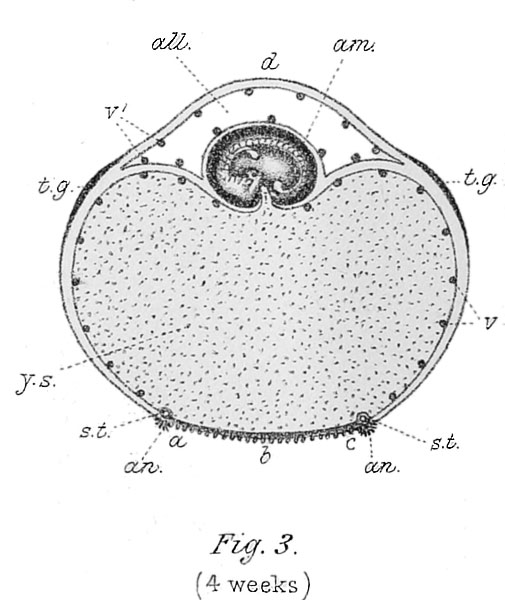File:Ewart1897 03.jpg
Ewart1897_03.jpg (505 × 600 pixels, file size: 54 KB, MIME type: image/jpeg)
Fig. 3. Four-weeks (28 days) horse embryo and its foetal appendages
A semi-diagrammatic representation of a four-weeks' (28 days) horse embryo and its foetal appendages. The embryo, which is curved so that the tail lies under the head, measures nearly three-eighths of an inch in length. The limbs are represented by lobes entirely composed of cells, i.e., the rudiments of the limb skeleton have not yet appeared. Behind the head are three arches and three clefts, but the clefts do not appear to open, as in fishes, into the pharynx. The amnion (am.) surrounds the embryo, and two stalks proceed from the under surface. The stalk proceeding to the left side connects the embryo with the yolk sac (y.s.), the stalk passing to the right contains the vessels of the allantois.
The allantois {all.) is already in contact with the embryonic sac (d), and with the amnion, and it has many vessels (v l ) in its wall. The yolk sac is vascular (v.), as far as the circular blood-vessel (s.t.), and crowded with granules which have entered by the absorbing area (a, b, c). The cells of the outer tunic at t.g. (on a level with the growing point of the allantois) have undergone considerable elongation, while the cells in the area {a, b, r) have given rise to a number of irregular ridges and processes.
| Historic Disclaimer - information about historic embryology pages |
|---|
| Pages where the terms "Historic" (textbooks, papers, people, recommendations) appear on this site, and sections within pages where this disclaimer appears, indicate that the content and scientific understanding are specific to the time of publication. This means that while some scientific descriptions are still accurate, the terminology and interpretation of the developmental mechanisms reflect the understanding at the time of original publication and those of the preceding periods, these terms, interpretations and recommendations may not reflect our current scientific understanding. (More? Embryology History | Historic Embryology Papers) |
Reference
Ewart, J.C. A Critical Period in the Development of the Horse. London: Adam and Charles Black (1897).
File history
Click on a date/time to view the file as it appeared at that time.
| Date/Time | Thumbnail | Dimensions | User | Comment | |
|---|---|---|---|---|---|
| current | 16:12, 3 May 2013 |  | 505 × 600 (54 KB) | Z8600021 (talk | contribs) |
You cannot overwrite this file.
File usage
The following page uses this file:

